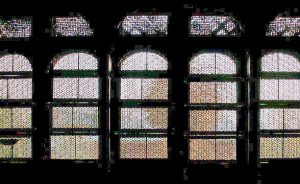Peace Watch » Editor's Take, Kashmir-Talk » Nimble Hands That Created Marvels Out of Wood
Nimble Hands That Created Marvels Out of Wood
Nostalgia
Carpenter with Nimble Hands
By
ZGM
 I was introduced to the nimble hands much before, my younger sibling and I began with our tender hands looking for pearls in Kawa-Shup (shells) in the dunes of driftwood in the firewood store of our house. I was introduced to them before; I could walk without my mother holding my hands. My first introduction to the skillful hands, which I admired in later days of my life was dark chocolate coloured vatanigour made from walnut wood. This nice tripod three wheel baby walker, a work of craftsmanship with small wooden pendants dangling like earrings of damsel on its central bar and the crossbar connected to the front wheel was part of family heirlooms. Grandmother once told me that many children born before my elder brother also had taken their first steps with the help of this very vatanigour and after babies walked on their own, the walker would go into Bayarkani (attic). Artisans that made artefacts like baby walkers in the city were called turki-chahan. This small section of artisans chiselled out different objects such as incense stick stands; candle stands, table lamps, and yender (spinning wheels). The carved walnut wood walkers were a rarity. Nevertheless, the gaudy coloured baby walkers
I was introduced to the nimble hands much before, my younger sibling and I began with our tender hands looking for pearls in Kawa-Shup (shells) in the dunes of driftwood in the firewood store of our house. I was introduced to them before; I could walk without my mother holding my hands. My first introduction to the skillful hands, which I admired in later days of my life was dark chocolate coloured vatanigour made from walnut wood. This nice tripod three wheel baby walker, a work of craftsmanship with small wooden pendants dangling like earrings of damsel on its central bar and the crossbar connected to the front wheel was part of family heirlooms. Grandmother once told me that many children born before my elder brother also had taken their first steps with the help of this very vatanigour and after babies walked on their own, the walker would go into Bayarkani (attic). Artisans that made artefacts like baby walkers in the city were called turki-chahan. This small section of artisans chiselled out different objects such as incense stick stands; candle stands, table lamps, and yender (spinning wheels). The carved walnut wood walkers were a rarity. Nevertheless, the gaudy coloured baby walkers  made of willow wood were sold at many stores that traded in small wooden items such mortar and pestles, rolling boards and pins, pashmina wool combing stands, winnows and Kangaris. The carpenters of Charisharif and Islamabad had expertise in making utility items out of willow wood including the coloured baby walkers- compared to those made from walnut wood these used to be very cheap.
made of willow wood were sold at many stores that traded in small wooden items such mortar and pestles, rolling boards and pins, pashmina wool combing stands, winnows and Kangaris. The carpenters of Charisharif and Islamabad had expertise in making utility items out of willow wood including the coloured baby walkers- compared to those made from walnut wood these used to be very cheap.
After bidding farewell to the walker my big introduction to the deft hands that created marvels out of wood, with their daze, chisel and handsaw were the latticed window shutters- some geometrical designs that I loved to peep through into the street outside as toddler and child. As I grew in age, it was the beautiful deodar varusi, that partitioned the front room of our house, morekh (eaves board) with its edge sawed to a design looking like waves of a river and the beautiful pendants resembling elegant earrings of the royalty at corners of roof our house that made me admire the creativity of our carpenters.
For carpenters dwelling in them many mohallas, in and around the city were called ‘channa Mohallas’. There was no channa Mohalla in our no locality but lot many of them lived in and around them, some gifted in boat and houseboat making, some proficient in designing roofs and dubs (wooden balconies), some masters in wooden interiors and some all-round best. I was in class six when I saw a septuagenarian, white-turbaned carpenter with sharp brownish eyes Abdul Ahad was commonly known as Vasta (master) Ahad working at our home. Our Sulher, small multi-purpose house similar to today’s outhouse that needed some repairs crumbled, and in its place, a new house was constructed, and Vasta Ahad and his two sons worked as carpenters. For the whole of winter, I saw this master craftsman working with an assortment of saws and chisels and creating marvels of craftsmanship out of deodar and kaayur. Seeing, him working was so engrossing that many times I earned an ire from my mother for wasting my staying with the carpenter for long hours, even getting late for tuition. Like a poet playing with words and creating mesmeric poetry, he used his tools and breathed life in the pieces of wood. Having mastered art of Panjarakari, he took them far beyond traditional geometric designs. I loved watching him using use his one and two centimetres wide and ten-inch long saws for sawing different flowers, narcissus, lotus and pansies out of planks of wood and piecing them together to give an ambience of the garden to the veranda of our house. Like an artist, he made a stunning marigola out of pieces of wood for our behtakh giving it a touch of royalty. It was a departure from the traditional margola made out of solid planks of wood for providing an ambience of the archway to doors of all rooms in the house.
The marvels created out of wood by these nimble hands to this day is a great treasure with us.
Filed under: Editor's Take, Kashmir-Talk







